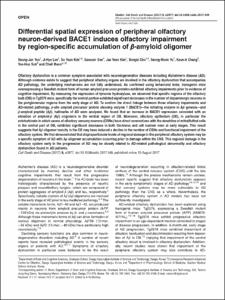Differential spatial expression of peripheral olfactory neuron-derived BACE1 induces olfactory impairment by region-specific accumulation of beta-amyloid oligomer
- Title
- Differential spatial expression of peripheral olfactory neuron-derived BACE1 induces olfactory impairment by region-specific accumulation of beta-amyloid oligomer
- Author(s)
- Yoo, Seung Jun ; Lee, Ji Hye ; Kim, So Yeon ; Son, Go Woon ; Kim, Jae Yeon ; Cho, Bongki ; Yu, Seong Woon ; Chang, Keun A ; Suh, Yoo Hun ; Moon, Che Il
- DGIST Authors
- Yoo, Seung Jun ; Lee, Ji Hye ; Kim, So Yeon ; Son, Go Woon ; Kim, Jae Yeon ; Cho, Bongki ; Yu, Seong Woon ; Chang, Keun A ; Suh, Yoo Hun ; Moon, Che Il
- Issued Date
- 2017-08
- Type
- Article
- Article Type
- Article
- Keywords
- BULB ; RAT ; SYSTEM ; DOPAMINE ; DISEASE MOUSE MODEL ; MILD COGNITIVE IMPAIRMENT ; ALZHEIMERS-DISEASE ; A-BETA ; TYROSINE-HYDROXYLASE ; TRANSGENIC MICE
- ISSN
- 2041-4889
- Abstract
- Olfactory dysfunction is a common symptom associated with neurodegenerative diseases including Alzheimer's disease (AD). Although evidence exists to suggest that peripheral olfactory organs are involved in the olfactory dysfunction that accompanies AD pathology, the underlying mechanisms are not fully understood. As confirmed using behavioral tests, transgenic mice overexpressing a Swedish mutant form of human amyloid precursor proteins exhibited olfactory impairments prior to evidence of cognitive impairment. By measuring the expression of tyrosine hydroxylase, we observed that specific regions of the olfactory bulb (OB) in Tg2576 mice, specifically the ventral portion exhibited significant decreases in the number of dopaminergic neurons in the periglomerular regions from the early stage of AD. To confirm the direct linkage between these olfactory impairments and AD-related pathology, beta-site amyloid precursor protein cleaving enzyme 1 (BACE1)-the initiating enzyme in A beta genesis-and beta-amyloid peptide (A beta), hallmarks of AD were analyzed. We found that an increase in BACE1 expression coincided with an elevation of amyloid-beta (A beta) oligomers in the ventral region of OB. Moreover, olfactory epithelium (OE), in particular the ectoturbinate in which axons of olfactory sensory neurons (OSNs) have direct connections with the dendrites of mitral/tufted cells in the ventral part of OB, exhibited significant decreases in both thickness and cell number even at early stages. This result suggests that A beta oligomer toxicity in the OE may have induced a decline in the number of OSNs and functional impairment of the olfactory system. We first demonstrated that disproportionate levels of regional damage in the peripheral olfactory system may be a specific symptom of AD with A beta oligomer accumulation occurring prior to damage within the CNS. This regional damage in the olfactory system early in the progression of AD may be closely related to AD-related pathological abnormality and olfactory dysfunction found in AD patients.
- Publisher
- Nature Publishing Group
- Related Researcher
-
-
Yu, Seong-Woon
- Research Interests Molecular mechanisms of neuronal cell death and neurodegeneration
-
- Files in This Item:
-
 기타 데이터 / 2.79 MB / Adobe PDF
download
기타 데이터 / 2.79 MB / Adobe PDF
download



